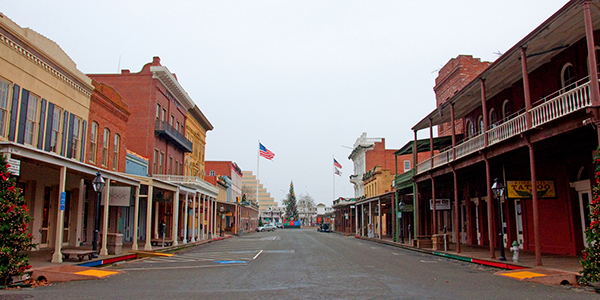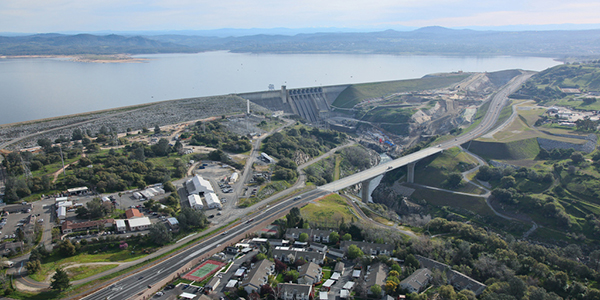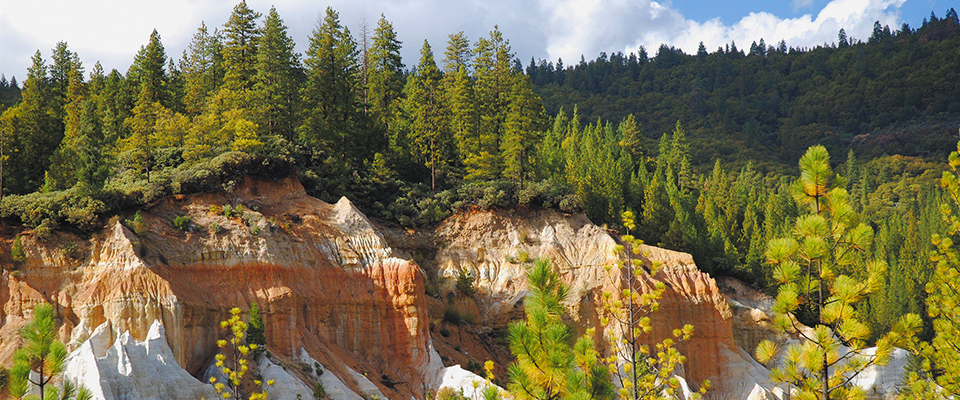Spotlight: Gold Country
Mine vacation memories at this treasure-rich destination
Walk in the footsteps of America’s great fortune seekers on a trip through California’s Gold Country. The state’s central region, from Oakhurst to the Sierra Nevada Mountains, is filled with rich finds of Gold Rush history and legend.
Madera County, the southernmost point of Gold Country, welcomes visitors to explore sites rich with prehistory. The Fossil Discovery Center displays fossilized remains of sabre-toothed cats, mammoths and other ancient species that roamed the region. Stop at the Yosemite Mountain Sugar Pine Railroad and hop on board the Logger, a steam-powered train that transports riders for four miles along Yosemite Park’s south gate, in the shadow of the Sierra National Forest.
The soil and climate of Madera County yield prized produce, such as wine, grapes and pomegranates. The fruits of the local farmers’ efforts are showcased at local cellars and wineries—jump on the Madera Wine Trail to taste the bounty of the region.
Expansive Mariposa County is the original site of 11 additional California counties, and it remains the largest of the state’s original 27 counties. This penchant for grandness extends to guests of Mariposa County, who can explore museums and history centers like the California State Mining and Mineral Museum that share the story of the Gold Rush and its impact on the region. Historic buildings remain intact in several small towns, including Coulterville. A stunning natural treasure, Yosemite National Park sits in Mariposa County, and it continues to draw nature lovers for birding, wildflower viewing, skiing and more.
Frontier life is a centerpiece of the Tuolumne County seat, the city of Sonora. The Wild West characters—gamblers, outlaws, miners and painted ladies—have left a lasting mark on the town built by the Gold Rush. Ride a stagecoach in Columbia and visit historic buildings that are still in service in the town of Groveland. Stanislaus National Forest reveals itself to be an ideal spot for fishing, boating, hiking and even panning for gold.

Steve Rouhotas
Fabulous Frogs
Mark Twain, pen name of Samuel Clemens, wrote about a famous jumping frog in Calaveras County, where the state’s Gold Rush was born and where towns from the era still stand. Hike into caves speckling the limestone cliffs, or stop in at a local winery for a taste of the region’s best vintages. Get your heart racing on a Stanislaus river rafting trip, then wind down with a calming sunset fishing trip.
Amador County lies at the heart of Gold Country, and it speaks to the hearts of visitors who love to seek out antique treasures and trek deep into the earth via gold mines and caves. Thrill seekers climb cliffs or mountain bike through rolling hills, while laidback types will enjoy fishing in streams and lakes or playing a round of golf on manicured greens. See how Amador’s early inhabitants lived on a trip to Indian Grinding Rock Historic State Park, and then quench your thirst at a local wine tasting.
California’s capital city is the seat of Sacramento County, which also is the gateway to numerous adventures. Traveling to Lake Tahoe takes visitors through the town of Folsom, famous for more than just its prison. The first railroad west of the Mississippi was laid here, and Folsom Lake welcomes watersport enthusiasts for boating and skiing. Folsom and Lake Natoma are bordered by several miles of biking trails. In the heart of Sacramento, stop by Sutter’s Fort to learn more about the history of the city.
East of Sacramento, El Dorado County includes South Lake Tahoe and its enticing blue water, where skiing and whitewater rafting are just two of the many aquatic activities available to guests. Peruse art galleries and sign up for a tee time at a local public golf course, then pop into a museum where the region’s past is impeccably preserved.

Life of Riley
The Super Sierra Nevada
The prize of Placer County is the Sierra Nevada, from the valley to the peaks and including Lake Tahoe. Once home to native tribes, Mexican settlers and gold miners, Placer County’s history is dotted with war, fortune and industry. Now the towns of Placer County draw visitors in to enjoy muscle cars on cruise nights, see original works of creativity on art walks, and enjoy music festivals and fairs.
The state’s richest gold mine is a well-preserved part of Nevada County’s history, as are historic downtown structures in the communities of Grass Valley and Nevada City. Tahoe National Forest and Malakoff Diggins State Historic Park attract hundreds of visitors each year with scenic hiking trails and meandering rivers.
Brave adventurers will get a kick out of a llama-assisted wilderness pack trip. Take a boat out on the South Yuba River and drop a line in for some great fishing. Railroad lovers should see the Nevada County Narrow Gauge Railroad and Transportation Museum, where historic Engine No. 5 makes its home.
Sierra County, the northernmost county in Gold Country, is a nature lover’s paradise. In the heart of the northern Sierra Nevadas, creeks and rivers, forest meadows and freshwater marshes are preserved for generations to come. The Lakes Basin is a mountainous destination for off-road vehicle riding, hiking and kayaking.
For More Information:
Gold Country Visitors Association
800-225-3764
www.calgold.org
California Travel and Tourism Commission
877-225-4367
www.visitcalifornia.com






